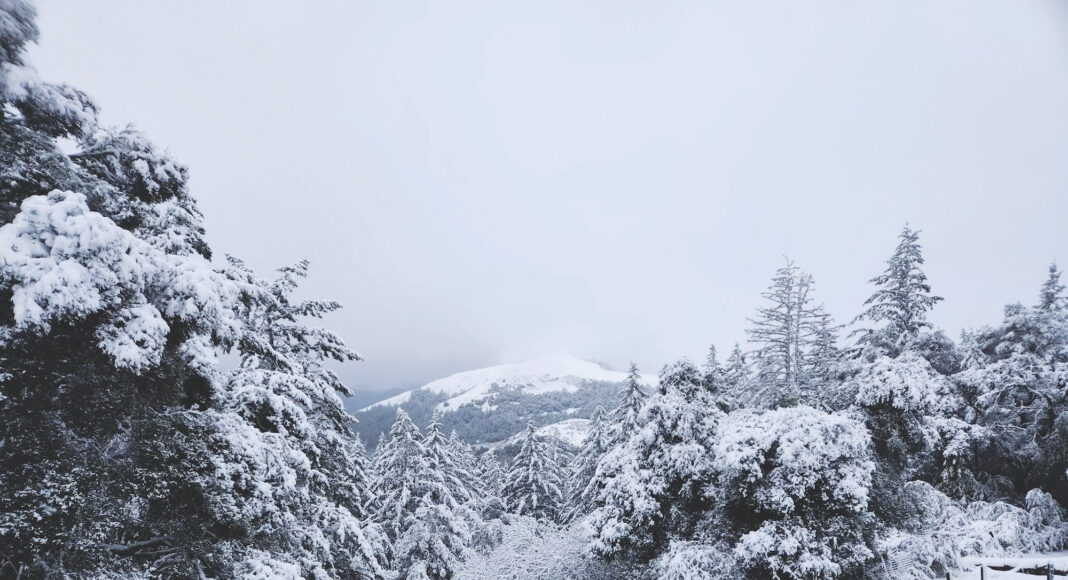People around Santa Cruz County geared up for power outages, road closures and a couple of rare snow days as a winter storm blew through the area on Thursday and Friday. Residents grabbed old surfboards, boogie boards and skim boards to ride down hillsides covered in snow that piled a foot deep in some parts of the mountains.
The cold temperatures reached lower elevations too. Areas just a few hundred feet above sea level received a light dusting of snow, including Twin Lakes State Beach, which turned white from graupel, also known as soft hail.
Sections of Hwy 17, Hwy 9 and several local roads closed for hours on Friday due to ice, snow, downed trees, slides and fallen power lines.
“Our safety concern was concerning travel and, obviously, the cold, so we’re trying to tell people if they need to warm up, head to the library or other public facilities,” says Jason Hoppin, the County of Santa Cruz communications manager.
In the past few years, snow has dusted the higher points of the Santa Cruz Mountains, but the intensity of this storm was rare. The National Weather Service issued a Winter Storm Warning in the area for the first time since 2011.
The unusual cold came from an airmass that flowed down from Canada. According to Jeff Lorber, a National Weather Service meteorologist, it brought moisture and gusty winds of up to 40 miles per hour.
“We have this ridge of high pressure [air] that’s several hundred miles off the coast, and since that’s way out to sea, it’s allowing these cold systems to ride over that ridge and then drop down the coast and bring this really cold source of air from British Columbia down the West Coast,” Lorber says.
Snow reached surprisingly low elevations, but this isn’t the first time in living memory. In 1976, a storm blanketed the City of Santa Cruz.
“There was actually snow on the beaches, on the boardwalk and the boats,” recalls UCSC distinguished professor of earth and planetary sciences Gary Griggs, who was teaching at the time.
For those using the unseasonable cold to deny climate change, Griggs points to the difference between long-term climate patterns and short-term weather events.
“A cold spell and snow on the beaches in California are not unheard of, but this says nothing about long-term climate change,” he says. “What is important to look at is the long-term change in average global temperature.”
Over several decades in Santa Cruz, Griggs has watched unusual weather and geological events unfold while studying the climate and history of the area. In a new Santa Cruz Museum of Natural History series, he will talk about the natural disasters that plague the county and what residents should plan for in the future.
Santa Cruz is the second-smallest county in California, but “we have more geologic hazards per square mile than any other county,” Griggs says. “From coastal storms and erosion to river flooding to rock falls/landslides/debris flows and then faulting and earthquakes—these events are actually very common, and the area has a long history of these disasters.”
Griggs’ lecture, titled Perils in Paradise and hosted at the London Nelson Center on Thursday, March 2, from 6-8pm, will include quick talks from other experts, including City of Santa Cruz climate action program manager Tiffany Wise-West and National Oceanic and Atmospheric Administration Fisheries Office climate scientist Nate Mantua.
An open house at the Santa Cruz Museum of Natural History and an extreme weather resource fair will follow on March 4 from 11am to 3pm. In the third and final event of the series, UCSC geology Ph.D. candidates will lead a tour of the rock formations, fault lines and history of erosion on West Cliff Drive on March 11.
“Our community has a long history of coming together in response to natural disasters. Understanding that historical context alongside science-based projections for the future can be empowering and even inspiring,” says museum executive director Felicia B. Van Stolk.
The organizers planned the event in response to the January storms and flooding many are still recovering from. The recent snow highlights these conversations’ importance as the county grapples with extreme weather events.














What times for the March 11 event? Where do we meet?
Most “climate activists” also demand open borders, literally inviting everyone on Earth to move to its most notorious carbon emitter.
It’s the science!!
🙂